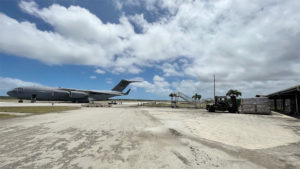 As the massive undersea Hunga Tonga Hunga Ha’apai volcano erupted on Saturday, Tongans from around the world gazed on as their relatives livestreamed images of billowing clouds of ash, gas and steam emerging from beneath the depths.
As the massive undersea Hunga Tonga Hunga Ha’apai volcano erupted on Saturday, Tongans from around the world gazed on as their relatives livestreamed images of billowing clouds of ash, gas and steam emerging from beneath the depths.
Then darkness.
The eruption severed Tonga’s single fibre-optic cable, rendering the entire Pacific archipelago offline and unable to communicate with the rest of the world — and leaving their loved ones terrified about what might have happened.
“It was absolutely crazy,” said Koniseti Liutai, a Tongan who lives in Australia.
“We were talking with family and relatives, because they were excitedly showing us the volcano’s activities, then we heard the explosion and the big bang and everything went dark,” he said. “Then the next information we got was the tsunami warning and then the tsunami hitting; we were all absolutely fearing the worst.”
It wasn’t only family and friends who could not get through. Huge ash clouds made backup communication by satellite phone next to impossible, and world leaders were not even able to get in touch with their Tongan counterparts to see what help they needed.
As the ash cleared, satellite communication improved and Tonga’s telecoms operator, Digicel, said it had been able to restore international call services to some areas late Wednesday.
It cautioned, however, that due to the high number of calls and the limited capacity of its satellite link that people may need to try repeatedly to get through — something experienced by Liutai, who is deputy president of the Tonga Australia Chamber of Commerce.
“My first direct information was this morning,” he said Thursday. “My daughter, after 100 phone calls during the day and night, got through to my aunties, my mum’s sisters, and we were in tears of joy — it was three in the morning, but for us it was like the middle of the day; we were so pumped and so happy.”
So far, three people have been confirmed killed after the volcanic eruption 64 kilometres (40 miles) north of Tonga’s capital, Nuku’alofa, and the tsunami that followed. Several small settlements in outlying islands were wiped off the face of the map, according to the Red Cross and official reports, necessitating the evacuation of several hundred residents.
With the resumption of some communications, more photos have begun to emerge of the destruction, showing the once-verdant islands turned a charcoal black by a thick coating of volcanic dust.
Coastlines are strewn with debris, while people work to clean streets and walkways.
The 2-centimetre (0.78 inch) layer of ash that rendered the runway at Fua’amotu International Airport unusable has now been cleared, and the first flights carrying fresh water and other aid arrived Thursday.
A repair ship is being sent from Papua New Guinea to work on the undersea cable, but it will take some time to get to Tonga and the company in charge estimates it could take longer than a month to repair the line.
Given that the cable runs right through the volcanic zone, any new volcanic activity could completely scupper even that timeline.
For Liutai, who runs a business in Tonga, regular visits had allowed him to stay in close touch in the past, but with COVID-19 pandemic travel restrictions, he has come to rely on video calls like many other Tongans living abroad.
With that possibility now cut off, at least for the near future, he’s hoping at least better telephone connections will soon be available so that the 106,000 residents of Tonga can better reach the outside world to tell their friends and family what’s going on.
“It’s something we’ve become so used to, talking to each other and sharing information with the ease of social media,” the 52-year-old said. “But when something scary has happened and you fear the worst, and even the government statement was general with no information, we were all nervous wrecks.”
